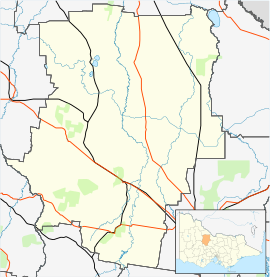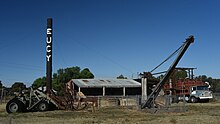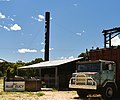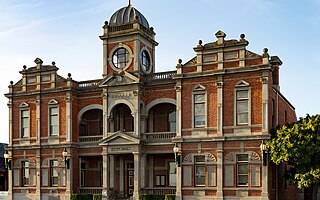
Castlemaine is a town in west central Victoria, Australia, in the Goldfields region about 120 kilometres northwest by road from Melbourne and about 40 kilometres from the major provincial centre of Bendigo. It is the administrative and economic centre of the Shire of Mount Alexander. The population at the 2021 Census was 7,506. Castlemaine was named by the chief goldfield commissioner, Captain W. Wright, in honour of his Irish uncle, Viscount Castlemaine.

Kingston is a town in the Shire of Hepburn in Victoria, Australia, located just off the Midland Highway about 10 kilometres distance from Creswick, and is about 20 km from Daylesford. Kingston's post code is 3364.

The Shire of Loddon is a local government area in Victoria, Australia, located in the northern part of the state. It covers an area of 6,696 square kilometres (2,585 sq mi) and in 2021 had a population of 7,759.
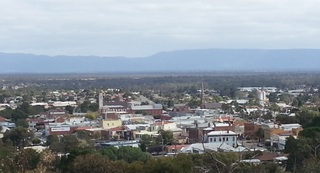
Stawell ( "stall"), is an Australian town in the Wimmera region of Victoria 237 kilometres (147 mi) west-north-west of the state capital, Melbourne. Located within the Shire of Northern Grampians local government area, it is a seat of local government for the shire and its main administrative centre. At the 2021 census, Stawell had a population of 6,220.

Wedderburn is a town in Victoria, Australia on the Calder Highway, 217 kilometres (135 mi) north of Victoria's capital city, Melbourne. At the 2021 census, Wedderburn had a population of 951. It is mainly a farming community but its early residents were gold miners and prospectors.

The Loddon River, an inland river of the north–central catchment, part of the Murray-Darling basin, is located in the lower Riverina bioregion and Central Highlands and Loddon Mallee regions of the Australian state of Victoria. The headwaters of the Loddon River rise on the northern slopes of the Great Dividing Range east of Daylesford and descend to flow north into the Little Murray River, near Swan Hill. The river is impounded by the Cairn Curran and Laanecoorie reservoirs.

Walhalla is a town in Victoria, Australia, founded as a gold-mining community in late 1862, and at its peak, home to around 4,000 residents. As of 2023, the town has a population of 20 permanent residents, though it has a large proportion of houses owned as holiday properties. It attracts large numbers of tourists and is a major focus of the regional tourism industry. The town's name is taken from an early gold mine in the area, named for the German hall of fame, the Walhalla temple.

Eucalyptus oil is the generic name for distilled oil from the leaves of Eucalyptus, a genus of the plant family Myrtaceae, mostly native to Australia but cultivated worldwide. Eucalyptus oil has a history of wide application, as a pharmaceutical, antiseptic, repellent, flavouring and fragrance, as well as having industrial uses. The leaves of selected Eucalyptus species are steam distilled to extract eucalyptus oil.

Macedon is a town at the foot of Mount Macedon in the Macedon Ranges, between Melbourne and Bendigo in central Victoria. It is administered by the Shire of Macedon Ranges. At the 2016 census Macedon had a population of 2,808. The combined population of Macedon and the nearby larger town of Gisborne was 21,071 at June 2016.

Marong is a town in Victoria, Australia. At the 2016 census, Marong and the surrounding area had a population of 1,416. It is 17 kilometres (11 mi) to the west of Bendigo. Its local government area is the City of Greater Bendigo. The town is at the junction of the Calder Highway (A79) and the Calder Alternate Highway (A790).

Bridgewater On Loddon is a town in north central Victoria, Australia. The town is located on the Calder Highway, north-west of Bendigo, astride the Loddon River. At the 2021 census, Bridgewater On Loddon had a population of 341. The rural area which surrounds Bridgewater on Loddon is named simply "Bridgewater".
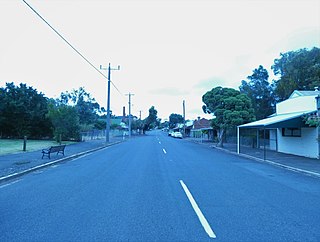
Tarnagulla is a town in central Victoria, Australia. The town is in the Shire of Loddon local government area, 183 kilometres (114 mi) north west of the state capital, Melbourne. At the 2011 census, Tarnagulla had a population of 304. By 2016, the population was 133.

The Shire of Korong was a local government area about 75 kilometres (47 mi) west-northwest of Bendigo, in western Victoria, Australia. The shire covered an area of 238.5 square kilometres (92.1 sq mi), and existed from 1862 until 1995.

The Shire of Newstead was a local government area about 120 kilometres (75 mi) northwest of Melbourne, the state capital of Victoria, Australia. The shire covered an area of 409.22 square kilometres (158.0 sq mi), and existed from 1860 until 1995.

Guildford is a town in Mount Alexander Shire, Victoria, Australia, situated on the Loddon River. It is located on the Midland Highway between Daylesford and Castlemaine and it is 124 kilometres (77 mi) north-west of Melbourne. The population recorded at the 2016 census was 333.

Campbells Creek is a town in Victoria, Australia.
Kingower is a locality in Victoria, Australia, located on Inglewood-Rheola Road, in the Shire of Loddon.

Timor (/ˈtaɪˈmɔː/), is a locality in Central Goldfields Shire, Victoria, Australia. Timor is located 8 kilometres (5 mi) north of Maryborough, Victoria and 178 kilometres (111 mi) northwest of Melbourne, the state capital. At the 2021 census, Timor had a population of 68.

Mount Franklin is an extinct volcano about 10 km north of Daylesford and 4.6 km south east of Franklinford in Victoria, Australia. A road spirals round the outside slopes covered with pine trees, into a flat 50 acre caldera, and onto the rim which hosts a fire lookout, parking area and picnic ground.
Rheola is a locality in central Victoria, Australia. At the 2011 census, Rheola and the surrounding area had a population of 316. Originally called the 'Berlin Rush' or 'Berlin field' after gold nuggets were found. It is part of Victoria's 'Golden Triangle,' which contains some of the world's richest gold fields. Some of the gold nuggets found in these fields include the Welcome Stranger, Hand of Faith, and the Blanche Barkly. The Viscount Canterbury, Viscountess Canterbury and Precious were all found in the gold field at Rheola.

